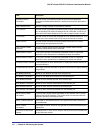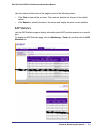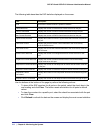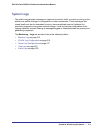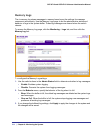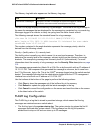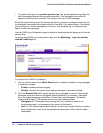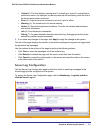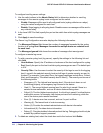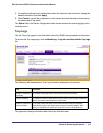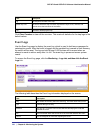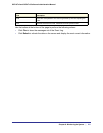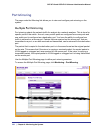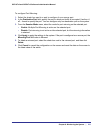
218 | Chapter 6: Monitoring the System
GS716Tv2 and GS724Tv3 Software Administration Manual
To configure local log server settings:
1. Use the radio buttons in the Admin Status field to determine whether to send log
messages to the remote syslog hosts configured on the switch.
• Enable: Messages will be sent to all configured hosts (syslog collectors or relays)
using the values configured for each host.
• Disable: Stops logging to all syslog hosts. Disable means no messages will be sent to
any collector/relay.
2. In the Local UDP Port field, specify the port on the switch from which syslog messages are
sent.
3. Click Apply to save the settings.
The Server Log Configuration area also displays the following information:
• The Messages Relayed field shows the number of messages forwarded by the syslog
function to a syslog host. Messages forwarded to multiple hosts are counted once
for each host.
• The Messages Ignored field shows the number of messages that were ignored.
To configure a remote log server
1. To add a remote syslog host (log server), specify the settings in the following list and
click Add.
• Host Address. Specify the IP address or hostname of the host configured for syslog.
• Port. Specify the port on the host to which syslog messages are sent. The default port
is 514.
• Severity Filter. Use the menu to select the severity of the logs to send to the logging
host. Logs with the selected severity level and all logs of greater severity are sent to
the host. For example, if you select Error, the logged messages include Error, Critical,
Alert, and Emergency. The default severity level is Alert(1). The severity can be one of
the following levels:
• Emergency (0): The highest level warning level. If the device is down or not
functioning properly, an emergency log is saved to the device.
• Alert (1): The second highest warning level. An alert log is saved if there is a
serious device malfunction, such as all device features being down.
• Critical (2): The third highest warning level. A critical log is saved if a critical device
malfunction occurs, for example, two device ports are not functioning, while the
rest of the device ports remain functional.
• Error (3): A device error has occurred, such as if a port is offline.
• Warning (4): The lowest level of a device warning.
• Notice (5): Provides the network administrators with device information.
• Informational (6): Provides device information.
• Debug (7): Provides detailed information about the log. Debugging should only be
entered by qualified support personnel.
2. To delete an existing host, select the check box next to the host and click Delete.



